
|   |

|   |
17th Dhauli-Kalinga Mahotsav - Nita Vidyarthi e-mail: nitavidyarthi@gmail.com Photos courtesy: Odisha Tourism March 10, 2021 The annual dance festival of Indian Classical and Martial Arts, held at Shanti Vihar, at the foothills of Dhauli, Bhubaneswar, is looked upon as the most significant occurrence in the national art calendar which establishes the glory of the soil to celebrate and reminisce humanity through history. Conceived by eminent Odissi Guru Gangadhar Pradhan, the three-day festival (Feb 6-8, 2021) well into its seventeenth year, is jointly organised by the Department of Tourism, Government of Odisha and Orissa Dance Academy in association with Art Vision, under the guidance of his distinguished disciple, the acclaimed Guru Aruna Mohanty, Secretary of Orissa Dance Academy. The main objective of this festival is to preserve, promote and popularize the heritage of the country's classical as well as folk performing arts traditions at the historical site replete with the serenity of the ethereal backdrop of the white Buddhist Pagoda atop the Dhauli Hills. Here the sense of history and originality is inseparable, where the natural and contemplative frame come together to portray the moments of peace, harmony, cultural solidarity and artistic excellence among the participants and the large audience comprising of artists, connoisseurs and the general public with the semi-asceticism of the majestic white pagoda. The multi-level stage offered opulence and a variegated character and uplifted the appeal of the performances. After the inauguration, every evening began with the offering of lighted marshals (torch) towards the Shanti Stupa by the dignitaries. 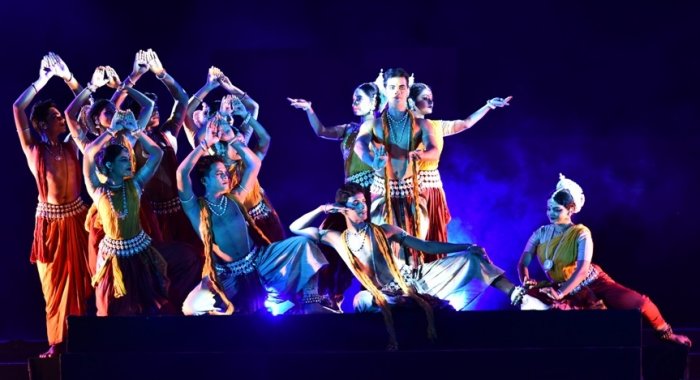 Orissa Dance Academy The fare this year was exotic. It began with a totally different interpretation and composition of Dasavataar, by the excellently trained dancers, both male and female, of Orissa Dance Academy. They documented their abilities to work in synchronisation and understanding to reveal the identity, essence and significance of the ten incarnations of Vishnu in this sterling piece. Kavi Jayadeva's Dasavataar, the first song of Gita Govinda, has been seen earlier innumerable times in all idioms but the concept of formulation of Vishnu's avatars conceived philosophically and interpreted by the erudite scholar Dr. Subhas Pani in the present production was unique. In this production, Jagannath, Krishna and Narayan were seen merging together with each other and creating the avatars one after the other and the images emerging one by one beautifully. Significantly, Krishna as an avataar is not included in the Dasavataar hymns. But perhaps spiritually and philosophically speaking, the concept is a viable interplay between jivatma and paramatma. However without going into controversy, this production, set to the inspiring choreography of Odissi dancer Sharmila Biswas, attuned to the highly enchanting musical composition of Dr. Pani, was definitely an unforgettable and rare experience. Sounds of conch shells and reverberation of "Om" followed by the splendour of the chorus "Harey Harey ....Jaya Jagadish Harey" created the right atmosphere for the welcome of the divine frieze - Ananatasajjya of Lord Vishnu in Kheerasagar with Lakshmi sitting at his feet. The song "Pralaya payodhijaley" celebrated the beginning of this much awaited performance. Two male dancers positioned themselves on the elevated platform merging into a brilliant imagery of Chaturbhuja Vishnu in the subtle light-washed expansive stage, while the others - mainly the female dancers - displayed the waves of "payodhijaley" through repeated sways with the amplitude of the music. After the vandana and pranam to Lord Vishnu by the dancing group, one of the male dancers joined the imagery of the duo at the elevated stage completing Dr. Subhas Pani's special interpretation of the merging of Jagannath, Krishna and Narayan. And then, with the nuanced singing the opulent images of 'Dasavataar' emerged sharply one after another as the dance drama proceeded like a series of brush strokes. The mellifluous phrases of the lilting raga was steeped with flourishes of intoxicating movements, turns , swirls, intricate nritta and involved performative skills, deftly strategized by Aruna Mohanty. A commendable feature of the production was that none of the dancers tried to establish their commanding presence and performed with excellent uniform training. Every moment and every postures of the nine dancers moving in tandem in perfect symmetry, as a unit as Ravana in the fight with Rama (the Rama Shariraavataar) stood out and spoke of rigorous training, discipline and choreographic excellence. Distinguished instrumentalists and musicians made the production an exciting challenge both for the dancers and the audience to quicken their vision and treat the concept and the execution from the standpoint of pure luxurious optical beauty. Vocals were by Rupak Kumar Parida and Matru Prasad, mardala by Bijoy Barik, violin by Suramani Ramesh Das and Agnimitra Behara with manjira by Sitakanta Jena and the intoxicating flute by Soumya Ranjan Joshi. 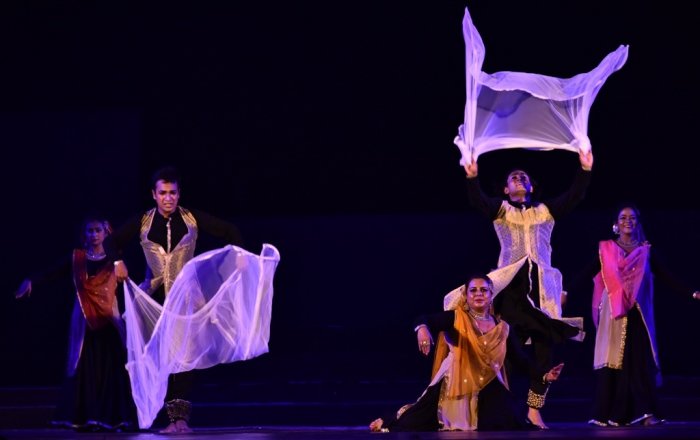 Upasana Centre for Dance The next production 'Pratibimba' by Kathak guru and choreographer Ashimbandhu Bhattacharjee with the dancers of his Upasana Centre for Dance, Kolkata, reflected through powerful Kathak, the myriad identities of man. The desire of man to remain entwined in human bondage and find fulfilment in his journey in life and be in togetherness like the masculine and the feminine, the good and the evil, the puppet and the invisible puppeteer and creation and destruction, one complementing the other were considered as Maya .They are mere reflections -"Pratibimba" or illusions - and Ashimbandhu recreated that Maya with the power and potential of the dance form especially footwork of variable mathematical combinations and permutations with his competent dancers. Ashimbandhu's work reflected the cycle and the existential quest of different phases of life philosophically through dance as a journey striving towards a destination. When the two coalesce, the cycle is complete and the Divine descends. Through controlled chakkars, the dancers displayed that everything moves in this world in destined determined orbits. Light effects at this point by Debiprasad Misra, enhanced the finale - that of life remaining as a trap of a blurred past and an unharboured future. Finally all the dancers led by Ashimbandhu at the fore with the spotlight on him faced towards the Pagoda, and moved gradually in a cluster with the chanting of "Buddham Sharanam Gacchami" as if reaching the Infinite as Divinity descends. Ashimbandhu's mellifluous music composition with the juxtaposition of piano, sarod and sitar apart from the usual percussions with symphony and ghungroos, have always remained exotic and this one was no exception. However the all-female number set to the popular Thumri "Eri sakhi more piya ghar aaaye" otherwise performed as a Qawalli too, though embellished with perfect chakkars, could not capture the nuances of the lyrics. Even though the group dynamics was good, use of stage space required more coordination. The black costumes could have been avoided considering the dark backdrop and diffused stage lights for better effects.  Mayurbhanj Chhau by Angika Chhau is always a delight to watch for its vigour, power and rugged theatricality. So the inclusion of all the three types of this martial art form was an exciting addition. The musical accompaniment on all three days was live, same in all the styles and comprised of the dhol, nagara, a kettle drum or dhumsa, and chadchadi (short cylindrical drum) as the percussion instruments and shehnai and reed pipes. The wind instrument mahuri is mostly replaced by the clarinet for keeping melody these days .The general technique or grammar of the performance is same for all three styles. Mayurbhanj Chhau by Angika, Bhubaneswar, led by Sadashiva Pradhan concluded the first evening with their explosive and endlessly dynamic 'Kapata Katha,' the tale of deceit displaying the compilation of four war episodes from Mahabharata, where the victory resulted from deceitful strategies. This style does not use masks but the face assumes the character of the mask by putting a fixed expression in tune with the theme, athletic body movements and gesture. And this was displayed with highly martial character in the four episodes by the well-trained group. They began with Bishma's 'Sharasajjya' (the bed of arrows) from Bishma Parva where the war was won with the help of Shikhandi. The imagery of the bed of arrows formed by the cluster of dancers was stunning. The next was the merciless killing of young Abhimanyu in Chakravyuha or Padmavyuha from the Drona Parva where the movements of the dancers in the lotus formation were a heart wrenching experience. The third episode was the killing of King Jayadrath by Arjun with the help of Lord Krishna, his charioteer. Arjun had promised to kill the lustful king before sunset. Lord Krishna hid the Sun for sometime by covering the sky with clouds and at this critical moment Arjun shot his ultimate missile, the Pasupataastra of Lord Shiva and severed Jayadrath's head and thereafter the Sun appeared. The final episode "Urubhanga"(Broken Thighs) was from Shalya Parva where Bhima during the mace fight (Gada Juddha) with Duryadhana on the last day of the battle, where Shalya was the commander, violated the rules and by false play smashed Duryodhana's thigh. Sukanta Kundu's vocals and Dhaneswar Swain's mardala added the necessary support to this thrilling and exciting performance. Distinguished Odissi and Hindustani vocalist Pandit Gopal Chandra Panda was conferred on the second evening with the Ruchi Buddha Samman instituted by the Ruchi Prathibha Foundation, followed by award of the Guru Gangadhar Pradhan Smruti Samman to K. Rama Rao Patra (eminent veena player), Shyamhari Chakra (journalist and dance critic), Dr. Snehaprava Samantra (Odissi dancer) and the late Tarakanta Panda (sound designer and music arranger). 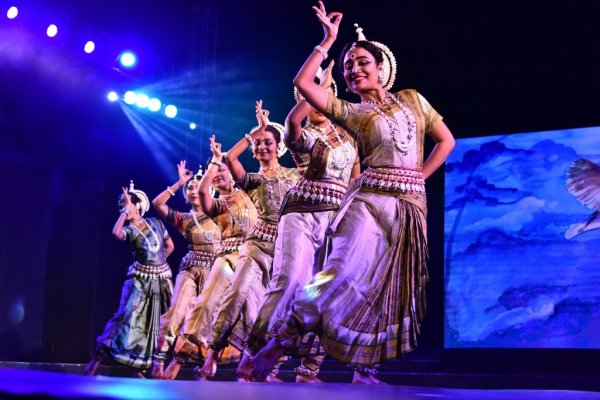 Art Vision On day two, the dance recitals opened with a fine Kolavati Pallavi in tala triputa by the skilled dancers of Art Vision choreographed and trained by Ileana Citaristi set to Guru Ghanashyam Panda's music and late Banamali Moharana's rhythm. This was followed by Kalidasa's 'Meghadootam,' the 111 stanza poem wonderfully encapsulated in 35 minutes with highly artistic inputs of music, singing and dancing. The "sandesa kavya" recounts how the exiled Yaksha, a subject of King Kubera, convinced a passing cloud to carry his message to his wife in Alaka on the foothills of Himalayas; of how he misses her. Ileana has stretched her intellect and imagination to portray the prominence of love and nature and the lyricism in the kavya beautifully with her competent dancers, not to say by herself as Yaksha. It was a delight to watch Ileana's nuanced performances as Yaksha and as Shiva with commendable Chhau movements. The choreographic experience and the journey towards North (Uttara Megh) replete with the beauty of Nature was a sample of a large spectrum of fascinating dance, blended with a thought provoking wide backdrop of the projection of a series of lovely paintings by Helen Brahma, accentuating the events of the path of the cloud. The mellifluous music by Lakshmikant Palit, rhythms by Sachidananda Das and light design by Lalatendu Panigrahi added impact to the execution and choreography of Ileana Citaristi. 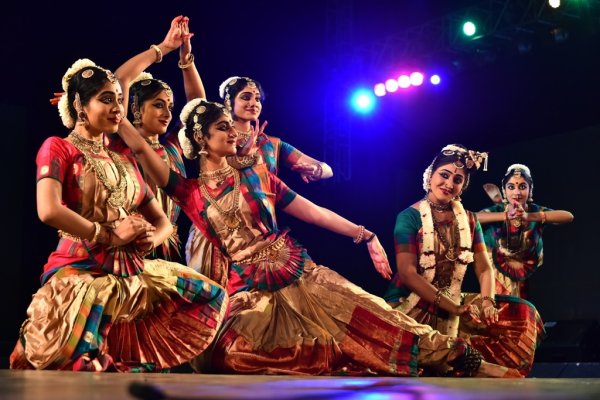 Bharatanjali ensemble The paasuram "Margazhi Thingal" was an invocation in Bharatanatyam by dancers of Bharatanjali from Chennai trained by Guru Anitha Guha . It showcased eight stories from Lord Krishna's miraculous deeds. The "Bali Vadha," the killing of King Bali by Dundhubi in their duel was next. The episode from the Ramayana was presented in the Jatiswaram format with exquisite jatis, interesting formations in linear formats in different elevations, the skilled dancers performing in perfect coordination. Saint Surdas's "Gopi Gopala Bala Rasamandala" was a lovely rhythmic number. Pancha Shivam, the five different forms of the Lord, had interpretative passages linked with sharp teermanams and was the highlight of their performance. Good use of stage space, bright costumes and vibrant dancing appealed. The energetic Thillana in raga Darbari Kanada and the Abhang, Bhimamaruti Sri Ramsevaka formed the concluding moments of this assorted presentation conceived and choreographed by Anitha Guha. 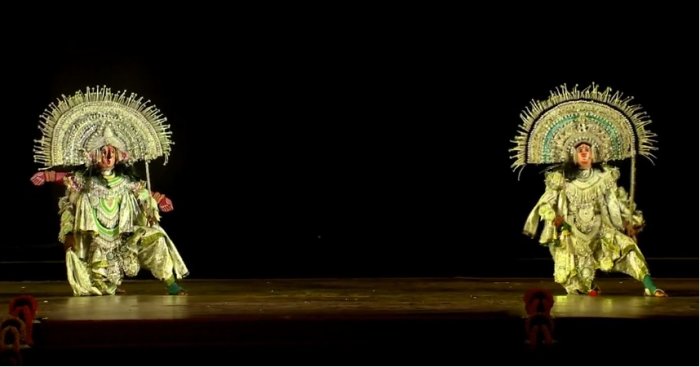 Purulia Chhau by Kalipada Chhau Nritya Samity Purulia Chhau is the most spectacular of the three and is a crowd-puller because of its popular themes especially Mahisasura Badh, colourful costumes and big bright elaborately decorated masks and headgear, often used as a decorative piece in homes. Kalipada Chhau Nritya Samity, Purulia, presented a highly enjoyable and vibrant "Mahisasura Mardini" under the guidance of Guru Susanta Mahato. The blazing performance began with chali as Ganesh entered in vilambit laya, (slow tempo), performed the invocatory dance followed by a few summersaults, the entertaining feats and the performance began accompanied by vibrant music with strong sounds of the clarinet. The other gods appeared one by one with their vahanas (divine vehicles). Kartik with stylised movements on a white peacock looked stunning. With the appearance of the trinity - Brahma, Vishnu and Maheswar - and chanting from Sri Chandi of "Ya Devi sarva bhuteshu Shakti rupena sangasthita...." Durga appeared. From "Astradan" equipping the Mother Goddess with weapons offered by different gods, till the killing of Mahisasura, the performance was a riveting display of techniques, competence, dedication and training by the endlessly dynamic dancers. The taming of the playful and stubborn Pashuraj, the lion, to agree to be the vahana of Goddess Durga for the Mahisasura Vadh was a delightfully entertaining sight executed by two dancers under a furry costume (cover). Their synchronisation and coordination even while running across the sprawling stage were commendable. Not a step was out of place till the end when they position themselves for the Goddess to ride on her vahana to kill the asura. What was novel in this wonderful production were the costumes which had a muted white and light green shade in place of the usually very colourful and jazzy ones. But nevertheless they looked quite beautiful. 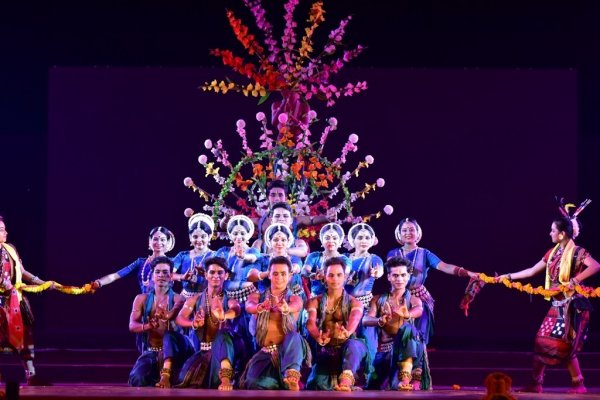 Ananya Odisha The third evening started with a kaleidoscopic 'Ananya Odisha' showcasing the different Jatras and festivals throughout the year - 'Baramasey Tero Jatra' (13 jatras in 12 months) with vibrant classical-folk fusion by Naivedya, Bhubaneswar. It is a celebration beginning with Chandan Jatra followed by Raja Utsav, Ratha Jatra, Durga Puja, Lakshmi Puja, to cite a few each month having its specific festivals. Brilliantly coloured costumes, happy, vibrant dancing with pulsating music the piece was a truly enjoyable experience. The lyrics by Kedar Mishra, set to music by Bijay Kumar Jena, Sachikanta Nayak and Guru Sumanta Mohanty, had rhythm composed by Guru Dhaneswar Swain and Guru Bijay Kumar Barik. Choreography was by Aruna Mohanty and Bijay Kumar Sahoo. Nrutyanilaya, Angul, under the guidance of Swapnarani Sinha presented "Agnisukta" with attractive, neat movements with ukuta by Dhaneswar Swain and accompanied by the chanting of slokas - beginning with "Om Agni rohita...Agnidevaya namoh" in Ramhari Das's voice followed by a pleasing Chakravak Pallavi composed by Guru Durgacharan Ranbir set to rhythm of Niranjan Patra in Nirmal Kumar Mohapatra's music where the dancers showed good grip on rhythm. 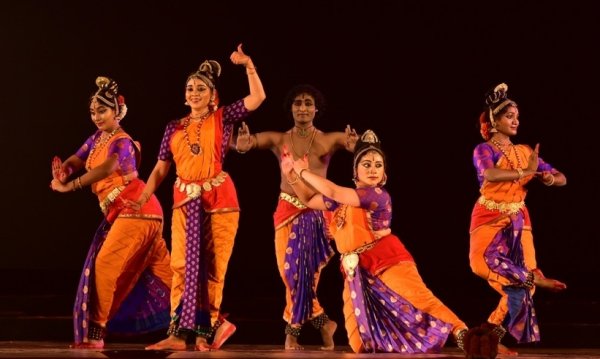 Shambhavi School of Dance A bunch of Kuchipudi numbers with versatile compositions were presented by Shambhavi School of Dance from Bengaluru led by Guru Vyjayanthi Kashi. "Adivo alladivo" a famous composition of Talapaka Annammacharya where he brings alive the mesmerising beauty and uniqueness of the seven hills were presented by the well-rehearsed group in keeping with the devotional vein. "Neela megha sareera" by Narayana Teertha in his Krishna LeelaTarangini exalted "Karmakanda", the leelas of Krishna with clean lines and perfect balance and match with the percussion on the brass plate with vocals by Ramya Suraj and Vijay. "Neela megha Krishna neela megha Madhava nityanandam dehi Balgopal Krishna" was a highly appealing number. The Kubja episode by Vyjayanthi Kashi saw the unclassifiable performative skills of the excellent dancer. Her intellect and refined abhinaya skills together with the reflective moods at the climax when Krishna appears and pulls her straight, revealed deep understanding and its evolution with time. 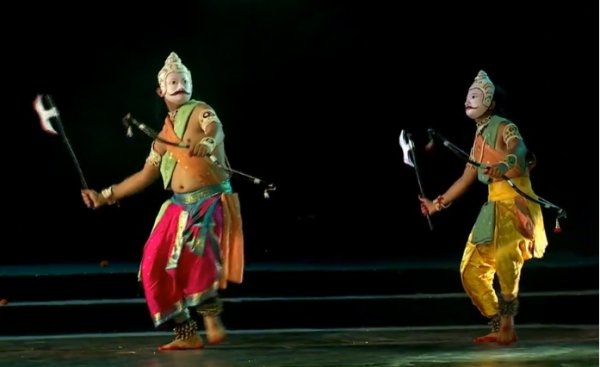 Seraikella Chhau by Acharya Chhau Nrutya Bichitra The festival closed with an undiluted, gorgeous, powerful Seraikella Chhau by Acharya Chhau Nrutya Bichitra from New Delhi led by Guru Shashadhar Acharya. They began with 'Jatraghat' set to raga Desh in16 beats, a number to evoke the gods and seek the blessings of the patron deity followed by "Bhupati Monoranjana" based on martial movements (to entertain the kings) on a special tala pattern, usually 8 and melody. Stretched strides and high energy well-crafted stylised movements, mostly linear and geometric by strong physically fit dancers were a delight to watch. 'Garuda Vasuki' set to raga Miyan-ki-Malhar and Charukeshi and tala-8 matras was a visual treat with the characteristic gaits or 'topkas' and 'uflis' of birds and snakes, lateral turns with the jerks and twists of the lower torso. They concluded with the 'Pharikhanda khelo' based on technical aspects that were common to the Akhada period in Seraikella Chhau. Phari means shield and Khanda means sword and this particular item was an important part of the training of soldiers of Seraikella. Now it is used for entertainment. A cutting edge performance moving to the front then turning and moving to the back, dynamic use of space, aerial bhramaris, strong placement of the foot on the floor and enormous vitality provided by the masks make the visually spectacular performance a thrilling experience. 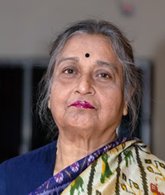 Dr. Nita Vidyarthi is a veteran critic of performing arts and writes on dance, music and theatre in leading publications. |